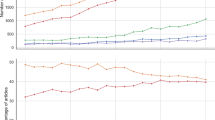Abstract
This work explores the attitudes of American scientists towardsinternational scientific activity, with particular respect to theoceanic sciences, during the three decades after the First WorldWar. In the mid-1950s, the Eisenhower Administration favouredthe thesis that increased international collaboration wouldstrengthen the Free World, ease Cold War tensions, and promotethe growth of science. This essay analyses elements in thatthesis, namely, scientific chauvinism, humanitarianism, andscientific interdependence. The narrative traces these themesthrough key episodes in the history of international cooperationin oceanic science, revealing how this experience shapedstrategies and expectations for cooperative scientific research.
Similar content being viewed by others
Author information
Authors and Affiliations
Rights and permissions
About this article
Cite this article
Hamblin, J.D. Visions of International Scientific Cooperation: The Case of Oceanic Science, 1920–1955. Minerva 38, 393–423 (2000). https://doi.org/10.1023/A:1004827125474
Issue Date:
DOI: https://doi.org/10.1023/A:1004827125474




